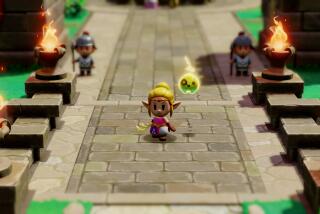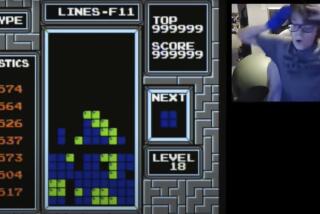Fun Ways to Off Your Friends Online; Yawner of a ‘Story’
- Share via
This column is about games. It doesn’t aim to change the world--just the idiosyncratic little corner of it in which vegetarian extraterrestrials and pistol-packing archeologist babes flicker across television screens and computer monitors.
Consumers bought $5.1 billion worth of video games last year--up nearly 40% from the year before. At their best, games whisk players to new worlds and challenge their imaginations.
Those thrills--as well as the visceral excitement of offing friends in a digital death match--are what keep players searching for the next cool thing. It’s a search I’ve been on since I first played Pong at a department store display decades ago. Every week, this column will highlight what I’ve found.
Its goals are twofold.
First, to help computer and video game players sort through the hundreds of titles piled on store shelves and separate the gems from the junk.
Second, to report on the state of an industry in which traditionally quirky little games have lost ground to corporate-backed behemoths that repackage genres a thousand different ways. Technically, games are better than ever. So why is it that play so often gets lost in an assault of polygons and textured surfaces?
Now, on to the games.
NETWAR AND TANARUS: Amid all the hype about online gaming, it’s easy to be a little cynical. Despite the explosion of Internet use, most of us still connect at relatively sluggish speeds. And given the hassle involved in getting regular games to run, the risk of server problems scares a lot of people.
Besides, why would someone want to play a game against someone they’ve never met?
But two online games for the PC highlight how easy it is to get up and running--and how much fun it can be. The onramps for “Netwar” and “Tanarus” are so smooth that anyone with a Windows 95 dialer and a reasonably speedy modem can be introducing complete strangers to the Grim Reaper within a few minutes of booting up.
Both “Netwar” and “Tanarus” are war games, but that’s where the similarity ends. In “Netwar,” players land in the middle of hand-to-hand combat and either blast away in a free-for-all or cooperate to fight opposing teams. The view is from above, with on-screen maps and radar providing a helpful heads-up to avoid ambushes. Players can accumulate bigger weapons--including tanks and choppers--as they explore sprawling environments.
Savagely simple, “Netwar” deserves a place in the pantheon of computer time killers, next to “Solitaire” and “Minesweeper.” The rules: If it moves, shoot it. If it still moves, shoot it again. That becomes repetitive, though, after a few hours of play.
“Tanarus,” on the other hand, demands considerable skill as players maneuver their tanks through arresting cityscapes. The perspective is first-person, and the controls allow considerable refinement of motion. Blasting enemy tanks takes nimble fingers and a cunning mind. One annoying thing about “Tanarus”: It took 21 minutes to download the latest software patches before I could begin playing.
Although neither title takes gaming to a new level, both are surprisingly sweet. There’s something to be said for playing against 30 or so players from around the country. Both games allow players to taunt one another with messages, a cool tweak that makes for tough talk. But not too tough, because system administrators can yank memberships.
Both “Netwar” and “Tanarus” require Windows 95 with a Pentium processor and at least 16 megabytes of RAM. Both run better with 32 MB of RAM, and “Tanarus” is optimized for a computer equipped with a 133-megahertz Pentium and graphics accelerator. Even without one, though, the game rolls smoothly. Of course, both games require a 28.8-kbps modem and a monthly membership. “Tanarus” charges $9.95 a month, with the first month free. Retail purchasers of “Netwar” get a year’s free membership.
YOSHI’S STORY: No one denies that Nintendo 64 is a wonder. But players over the age of 8 have to wonder how Nintendo thinks it can survive with bizarre games like “Yoshi’s Story.”
Essentially a side-scroller, “Yoshi’s Story” follows the adventures of a group of young Yoshis--the turtle-like creatures that figure prominently in many Nintendo games--as they search for the stolen Super Happy Tree.
A visiting toddler pointed at the screen as I played and said, “Pretty.” That it is. But that’s about all it is. It’s standard 2-D jump-kick-and-roll fare dolled up with fancy graphics and a saccharine soundtrack.
Yes, this is a kid’s game, but I can’t imagine any but the youngest children getting excited about yet another Yoshi saga. Nintendo prides itself on producing games that won’t make parents cringe, but with “Yoshi’s Story,” all you get is wholesome and cheery.
Nintendo 64 boasts some good games. Remember “Turok the Dinosaur Hunter”? Or “Mario”? Or “GoldenEye 007”? Let’s hope the golden age of Nintendo 64 games has not come and gone. If Nintendo wants players to take it seriously, it needs to take players seriously.
COLOR GAME BOY: Nearly a decade after its release, the best-selling portable game machine will finally get a color display. Game Boy’s black and white LCD screen is murder on the eyes--a problem not even the sharper display of Game Boy Pocket completely solved.
Whether color will do the trick remains to be seen because Nintendo isn’t talking details--or showing demos--just yet. All that’s certain is that the rig, which will be about the size of Game Boy Pocket, will display up to 56 simultaneous colors out of a palette of 32,000.
Despite Game Boy’s relatively primitive technology, Nintendo has sold 60 million units worldwide by keeping them cheap and easy on the batteries. Color Game Boy, the company promises, will be true to that tradition.
*
Times staff writer Aaron Curtiss will review video games weekly in The Cutting Edge. To comment on a column or suggest games for review, e-mail aaron.curtiss@latimes.com
(BEGIN TEXT OF INFOBOX / INFOGRAPHIC)
The Essentials
Netwar
Platform: PC CD-ROM
Publisher: Headland Digital Media
ESRB* rating: Teen
Price: $39.95; shareware version available free at https://www.netwar.com
Bottom line: No learning curve, and that’s a problem.
*
Tanarus
Platform: PC CD-ROM
Publisher: Sony Interactive Studios America
ESRB rating: Kids to adults
Price: $19.95; shareware version available free at https://www.tanarus.com
Bottom line: Smooth and elegant; engages the brain.
*
Yoshi’s Story
Platform: Nintendo 64
Publisher: Nintendo
ESRB rating: Everyone
Price: $59.95
Bottom line: Captivates toddlers only.
*Entertainment Software Ratings Board
*
Next Week: Quake II, Jedi Knight, Mysteries of the Sith Companion Missions, Steep Slope Sliders, Cool Boarders 2
More to Read
The biggest entertainment stories
Get our big stories about Hollywood, film, television, music, arts, culture and more right in your inbox as soon as they publish.
You may occasionally receive promotional content from the Los Angeles Times.










